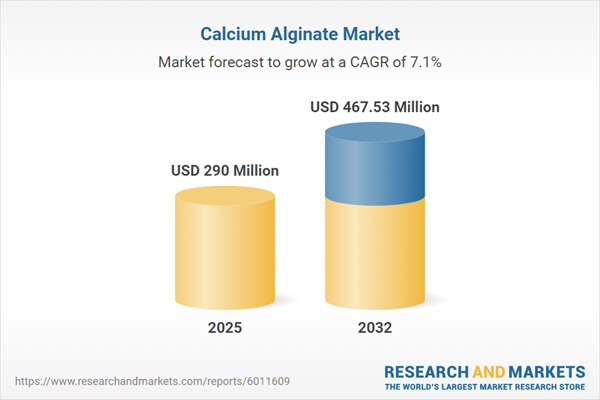Speak directly to the analyst to clarify any post sales queries you may have.
The calcium alginate market is evolving rapidly, driven by advancements in biopolymer technologies and a shift toward sustainability across industries. Senior stakeholders should recognize how this versatile material, valued for its gel-forming and biocompatible properties, continues to gain strategic importance in medical, food, and textile applications.
Calcium Alginate Market Snapshot
The global calcium alginate market grew from USD 270.82 million in 2024 to USD 290 million in 2025. Sustained by a CAGR of 7.06%, the market is forecast to reach USD 467.53 million by 2032. Growth is supported by robust demand in medical wound care, food stabilization, and textile processing, alongside increased adoption in emerging segments. Innovations in microencapsulation, film-casting, and bio-fermentation enhance product performance, closely aligning the sector with trends in biodegradable packaging, clean-label ingredients, and advanced pharmaceuticals.
Scope & Segmentation
This report provides strategic segmentation and comprehensive analysis across market dimensions, technologies, end uses, and leading manufacturers.
- Type: Fibers, Films, Microspheres
- Application: Cell Encapsulation, Drug Delivery (injectable, oral, transdermal), Food Additives (stabilizer, thickener), Textile Sizing, Wound Dressing (film, foam, hydrogel)
- Purity Grade: Food Grade, Pharma Grade, Technical Grade
- End User Industry: Agriculture, Cosmeceutical, Food and Beverage, Pharmaceutical, Textile
- Source: Bacterial Fermentation, Brown Seaweed
- Sales Channel: Direct, Distributors, E Commerce
- Geographic Coverage: Americas (United States, Canada, Mexico, Brazil, Argentina, Chile, Colombia, Peru), Europe, Middle East & Africa (United Kingdom, Germany, France, Russia, Italy, Spain, Netherlands, Sweden, Poland, Switzerland, United Arab Emirates, Saudi Arabia, Qatar, Turkey, Israel, South Africa, Nigeria, Egypt, Kenya), Asia-Pacific (China, India, Japan, Australia, South Korea, Indonesia, Thailand, Malaysia, Singapore, Taiwan)
- Selected Companies: The International Flavors & Fragrances Inc., J.M. Huber Corporation, Cargill, Incorporated, KIMICA Corporation, Algaia S.A.S., Qingdao Gather Great Ocean Algae Industry Group Co., Ltd., Ashland Global Holdings Inc., Ingredion Incorporated, MBH Algen GmbH, Alginor AB
Key Takeaways
- Calcium alginate’s unique gel-forming ability underpins innovation in advanced drug delivery, wound management, and texture modulation for food products.
- Recent advances in microencapsulation and bio-based processing are critical to expanding high-value applications, especially in health and personal care.
- Integrating renewable sources and sustainable extraction methods is enhancing supply chain resilience and aligning with global environmental standards.
- Market segmentation by application and purity grades provides targeted business opportunities in sectors such as cosmeceuticals and cell therapy development.
- Regional growth depends on localized regulatory policies, infrastructure advances, and investment in raw material sourcing—enabling differentiated strategies across North America, Europe, Asia-Pacific, and beyond.
- Strategic cooperation between global manufacturers and regional processors enables rapid adaptation to shifting consumer expectations and accelerated adoption of eco-friendly technologies.
Impact of Revised US Import Tariffs
The 2025 revision of US calcium alginate import tariffs is reshaping market dynamics, prompting manufacturers to reassess sourcing strategy and cost structures. Increased duties have led some firms to strengthen domestic purification and seek alternative sources, influencing both downstream pricing and development plans. This adjustment is driving greater agility in inventory management, while regional competitors leverage logistics advantages to maintain market share.
Calcium Alginate Market Methodology & Data Sources
The report is grounded in extensive primary research, including executive interviews and technical validation, combined with analysis of authoritative secondary sources. Data triangulation, geospatial mapping, and supply chain analytics assure robust segmentation and reliable trends. Proprietary databases enhance assessment of competitive positioning and investment strategies.
Why This Report Matters
- Facilitates strategic decisions by providing in-depth visibility into trends, technology advances, and evolving regulatory conditions within the calcium alginate market.
- Enables prioritization of investments across growth segments and regions backed by actionable insights on segmentation, sourcing, and market entry.
- Supports risk mitigation through comprehensive analysis of tariff impacts, supply chain strategies, and sustainable sourcing approaches relevant to industry leaders.
Conclusion
The calcium alginate market’s trajectory is shaped by integration of technological innovation, sustainability, and regulatory adaptation. Decision-makers targeting growth can leverage this report’s actionable intelligence to align strategic priorities and strengthen market presence.
Additional Product Information:
- Purchase of this report includes 1 year online access with quarterly updates.
- This report can be updated on request. Please contact our Customer Experience team using the Ask a Question widget on our website.
Table of Contents
3. Executive Summary
4. Market Overview
7. Cumulative Impact of Artificial Intelligence 2025
Companies Mentioned
The companies profiled in this Calcium Alginate market report include:- The International Flavors & Fragrances Inc.
- J.M. Huber Corporation
- Cargill, Incorporated
- KIMICA Corporation
- Algaia S.A.S.
- Qingdao Gather Great Ocean Algae Industry Group Co., Ltd.
- Ashland Global Holdings Inc.
- Ingredion Incorporated
- MBH Algen GmbH
- Alginor AB
Table Information
| Report Attribute | Details |
|---|---|
| No. of Pages | 185 |
| Published | October 2025 |
| Forecast Period | 2025 - 2032 |
| Estimated Market Value ( USD | $ 290 Million |
| Forecasted Market Value ( USD | $ 467.53 Million |
| Compound Annual Growth Rate | 7.0% |
| Regions Covered | Global |
| No. of Companies Mentioned | 11 |









